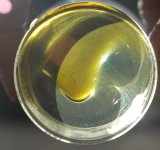Waterbelly
Member
So what i believe youre saying is that the thicker pools might have appeared darker because of the light refraction? It makes sense, but unfortunately a side by side comparison between the dabs showed a significant color difference. It is not the first time i have seen evidence of heat darkening the product, nor the first time i have heard of it happening.



